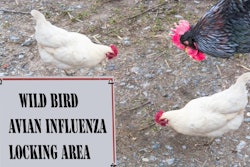
While the seasonal decline in highly pathogenic avian influenza (HPAI) in the world’s poultry appears to be continuing, new outbreaks have been confirmed in Bangladesh, South Africa, Taiwan and Togo, and Chinese authorities have reported a new strain of the disease in the commercial sector.
Avian influenza cases in Asia
China’s agriculture ministry has reported to the OIE an outbreak of HPAI linked to the H7N9 virus variant, which it describes as a new strain of the disease. The presence of the virus was confirmed after almost 600 laying hens out of a flock of 13,578 birds died in Ningxia. Located in the north-west of China, Ningxia Hua Autonomous Region borders the province of Shaanxi, where a similar virus hit a layer flock in February this year.
OIE has been notified by the authorities in Hong Kong that an H5N6 HPAI virus was detected in one of more than 2,800 birds at a street market in March. All the birds were destroyed, and the Yuen Po market was closed for 21 days to allow cleaning and disinfection to be carried out.
According to the latest Taiwanese agriculture ministry report to the World Organisation for Animal Health (OIE), there have been four new outbreaks of HPAI linked to the H5N2 virus variant so far in April. Almost 63,000 poultry were lost to the disease through mortality or destruction in these outbreaks. Latest to be affected were three flocks of native chickens in the cities of Tainan and Taichung, and Changhua county, and more than 31,500 breeding chickens in Yunlin county.
A further outbreak in Taiwan — a third in the city of Tainan so far this year — has been confirmed in a flock of more than 10,800 free-range chickens, according to Focus Taiwan last week. This source gives Council of Agriculture figures of 63 HPAI outbreaks in Taiwan so far this year, and more than 473,000 poultry culled.
The Ministry of Fisheries and Livestock in Bangladesh has reported to the OIE a new outbreak of HPAI in poultry caused by the H5N1 virus. The outbreak in March caused the death of 385 poultry at a college in Jhenaidah in Khulna, which is a division in the south-west of the country. This is the fifth outbreak of HPAI since the disease returned to Bangladesh in early 2017.
Three months after a single outbreak of H5N6 HPAI in Japan, the Ministry of Agriculture, Forestry and Fisheries has declared to the OIE that the country’s poultry sector is free of avian flu. The affected broiler farm in Kagawa prefecture was depopulated in January, cleaned and disinfected, and surveillance has revealed no further cases in the nation’s poultry.
Africa: HPAI returns to Togo
After an absence of five months, HPAI caused by the H5N1 virus variant has returned to the West African state of Togo. According to the agriculture ministry report to the OIE, an outbreak was confirmed in a backyard poultry flock including layers and broilers at the end of March. Of the around 5,000 birds, more than 3,600 died and the rest have been destroyed. The outbreak occurred at an agropastoral facility in the southernmost state of Region Maritime. Source of the infection is unknown.
South Africa’s veterinary authority has confirmed to the OIE two outbreaks of H5N8 HPAI in commercial poultry reported previously by the local press. Affected were farms with 4,500 birds in Maquassi Hills, and more than 36,500 ducks and quails in Madibeng—both in North West Province. While more than 580 of the birds died, the fate of the rest of the flocks is not reported.
Between January 23 and March 22, there were five further outbreaks of HPAI in South Africa that did not involve commercial poultry. These bring the country’s total outbreaks linked to the H5N8 virus subtype since June last year to 176. A flock of 85 hobby ducks in the north-western province of Limpopo accounted for one of these outbreaks, while the rest were in a total of 25 wild birds found dead at four coastal locations in Western Cape Province.















